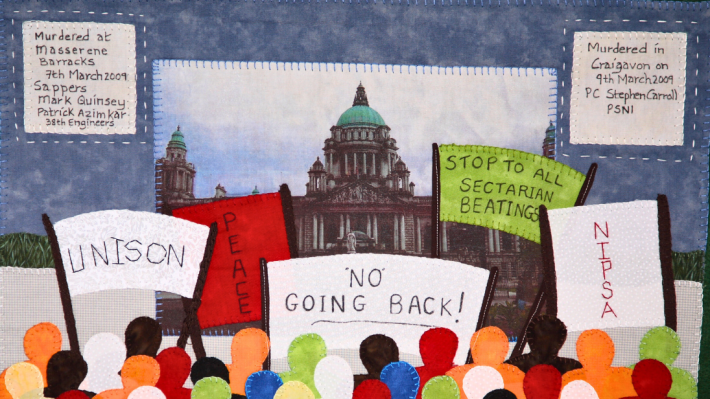
peace quilt - common loss
Between 1969 and 1994 more than 3,000 people died as a result of the conflict, many of whom were civilians. Each piece of red fabric, deliberately torn to convey a sense of destruction, represents one of those who died.
As the work began to take shape, people from Northern Ireland, Japan, the USA and England sent pieces of red fabric to Irene for inclusion. The white birds represent the dove of peace and the teddy bear reminds us of the children who were killed and the many more who suffered the loss of loved ones.
Irene MacWilliam

Photo credit: Susan MacWilliam © Conflict Textiles
A quilter and embroiderer, much of Irene MacWilliam’s work has dealt with the impact of conflict on children and families. She began machine appliqué in 1985, and in 1986 began making Events of the Year quilts, these are now in the Ulster Folk Museum collection. The Ulster Museum purchased this quilt in 2021, as part of our ongoing development of the Troubles and Beyond collection. Irene’s work has been widely exhibited in Northern Ireland, Ireland and internationally.
Conflict Textiles commissioned this textile portrait of Irene MacWilliam, specifically to coincide with the exhibition Threads of Empowerment: Conflict Textiles' International Journey. Through it we gain an insight into her work as a textile artist and the breadth and depth of issues she has highlighted through textile language over several decades; the Northern Ireland conflict, the environment, climate change, displacement, disappearance, the impact of war on children and non-violence.

Explore more
Walking Alongside the Arpilleras
Textile artist Janet Wilkinson shares how she became involved in textile art, and the creation of her powerful appillera ‘Life With and Without Bees’.
Troubles Art
Explore a range of responses to the Troubles by artists from Northern Ireland and beyond.
Conflict Textiles
When words are not enough to express lived experiences of violence, stitching and sewing emerge as textile language.








